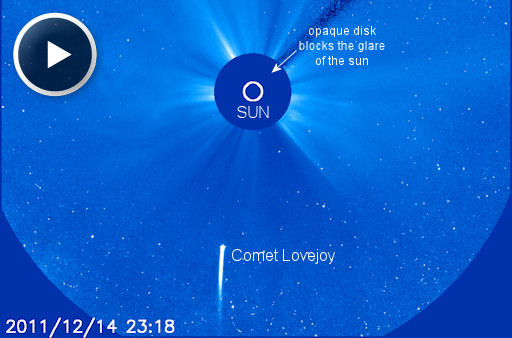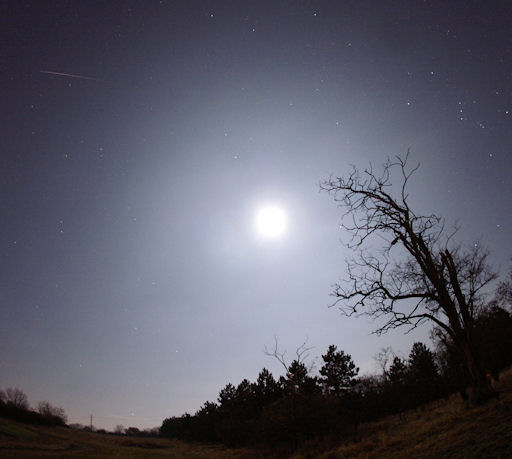~Space Weather Update~ 12~14~11~
~Comet Love Joy Heads Into The Sun~

CURIOSITY AND THE SOLAR STORM: Last month, a massive solar storm launched itself toward Mars just as NASA's new rover, Curiosity, was blasting off from Cape Canaveral in the same direction. Researchers say it was a welcome coincidence. For the first time in Mars-rover history, Curiosity is equipped to study solar storms, and it will be monitoring space weather all the way to the Red Planet. [full story]
BIG COMET PLUNGES TOWARD THE SUN: Comet Lovejoy (C/2011 W3) is diving into the sun and furiously vaporizing as it approaches the stellar surface. The Solar and Heliospheric Observatory (SOHO) is recording the kamikaze plunge:
"This is, without any doubt, the brightest sungrazing comet that SOHO has ever seen," says comet researcher Karl Battams of the Naval Research Lab in Washington DC.
The comet's nucleus, thought to be twice as wide as a football field, will skim approximately 140,000 km (1.2 solar radii) above the solar surface on Dec. 15/16. At such close range, solar heating will almost certainly destroy the comet's icy core, creating a cloud of vapor and comet dust that will reflect lots of sunlight.
"If Comet Lovejoy gets as bright as magnitude -4 or -5, there is a tiny but non-zero chance that it could become visible in the sky next to the sun," says Battams.
Indeed, something similar happened to Comet McNaught in January 2007 when it was visible in broad daylight: gallery. Standing in the shadow of a tall building to block the sun allowed the comet to be seen in blue sky nearby.
"Comet Lovejoy will be reaching perihelion (closest approach to the sun) right around sunset on Dec. 15th for people in the US East, Central, Mountain, and Pacific time zones," continues Battams. "Be alert for the comet to the left of the sun at that time." Caution: Do not look at or near the sun through unfiltered optics; focused sunlight can seriously damage your eyes.
Discovered on Dec. 2nd by amateur astronomer Terry Lovejoy of Australia, the comet is an unusually large member of the Kreutz family. Kreutz sungrazers are fragments of a single giant comet (probably the Great Comet of 1106) that broke apart back in the 12th century. SOHO sees one plunging into the sun every few days, but most are small, no more than 10 meters wide. Comet Lovejoy is at least ten times larger than usual.
Got pictures of Comet Lovejoy? Submit them here.
GEMINID METEOR UPDATE: Today, Earth is passing through a stream of debris from near-Earth asteroid 3200 Phaethon, source of the annual Geminid meteor shower. Often the encounter produces more than 100 Geminids per hour, but this year many of the meteors are obscured by bright moonlight. Visual rates are currently in the dozens, not hundreds.
"Last night, I spent two hours outdoors and witnessed a good shower despite the strong moonlight," reports Monika Landy-Gyebnar, who sends this picture (and others) from Veszprem, Hungary:
"I'm happy I had 2 hours of beauty among the brightening dust of the asteroid Phaethon!" she says.
Another way to enjoy the Geminids is by listening to them. The US Air Force Space Surveillance Radar is scanning the skies over the southern USA. When a Geminid flies overhead--ping!--there is an echo. This method of observing is unaffected by moonlight. Live audio from the radar is playing on Space Weather Radio.

Solar wind
speed: 375.8 km/sec
density: 0.7 protons/cm3
explanation | more data
Updated: Today at 0042 UT
X-ray Solar Flares
6-hr max: C7 1946 UT Dec14
24-hr: C7 1459 UT Dec14
explanation | more data
Updated: Today at: 2359 UT
![]()
Daily Sun: 14 Dec 11
Departing sunspot 1367 is crackling with C-flares. Everything else is quiet. Credit: SDO/HMI
![]()
Sunspot number: 77
What is the sunspot number?
Updated 13 Dec 2011
Spotless Days
Current Stretch: 0 days
2011 total: 2 days (<1%)
2010 total: 51 days (14%)
2009 total: 260 days (71%)
Since 2004: 821 days
Typical Solar Min: 486 days
Updated 13 Dec 2011
The Radio Sun
10.7 cm flux: 133 sfu
explanation | more data
Updated 13 Dec 2011
![]()
Current Auroral Oval:
Switch to: Europe, USA, New Zealand, Antarctica
Credit: NOAA/POES
![]()
Planetary K-index
Now: Kp= 0 quiet
24-hr max: Kp= 1 quiet
explanation | more data
Interplanetary Mag. Field
Btotal: 2.7 nT
Bz: 0.8 nT south
explanation | more data
Updated: Today at 0045 UT
![]()
Coronal Holes: 14 Dec 11
There are no large coronal holes on the Earthside of the sun. Credit: SDO/AIA.





